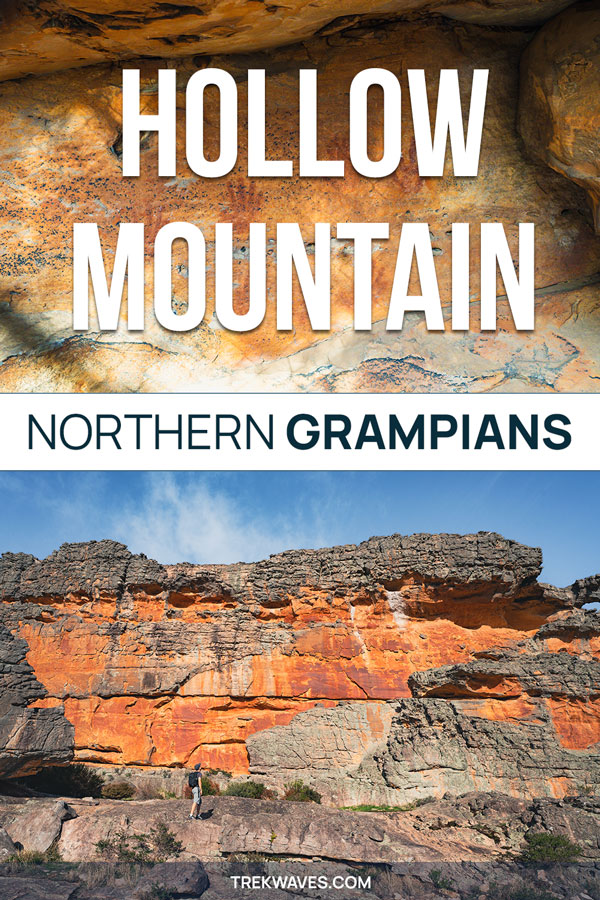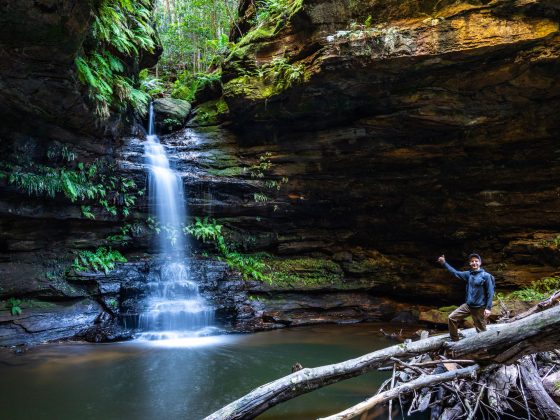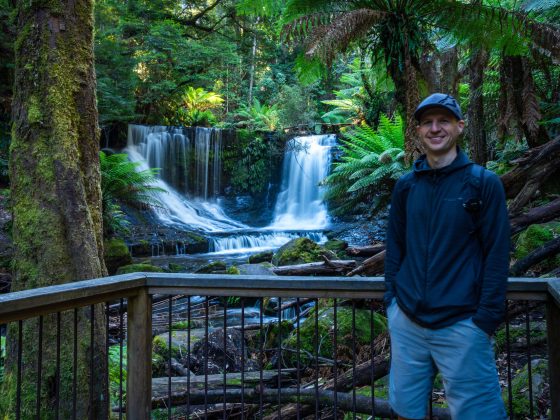Hollow Mountain marked the end of my week-long exploration of Grampians National Park, and while it’s not a long hike, it’s a must-do when you’re in the area.
It’s far from an ordinary hiking trail—here, you’ll be scaling giant boulders, squeezing through narrow rock caves, and scrambling up steep rock faces.
At the summit of Hollow Mountain, you’ll be rewarded with sweeping views of the ancient volcanic plains, a sight that is simply unforgettable.
I set out on this hike in the early morning, and the vibrant orange rocks, glowing in the soft light, made the entire landscape feel surreal and otherworldly.
Located in the heart of Victoria’s Northern Grampians, this hike also offers a deep connection to Australia’s indigenous past. Ancient handprints on the rock walls at the Gulgurn Manja Shelter silently tell the stories of the first people to inhabit this land, adding a historical layer to the adventure.
If you’re looking for a thrilling hike with historical significance, read on, as I’ll guide you through everything you need to know for this one-of-a-kind trek.
How To Get To Hollow Mountain Trail
The Hollow Mountain trailhead is situated in the Northern Grampians, about 35 minutes from Halls Gap via Mount Zero Road, or roughly 50 minutes if you opt for the A8 route.
When I visited, Mount Zero Road was closed due to roadworks, so I can’t speak to its current condition.
For navigation, enter Hollow Mountain Carpark into your GPS, which is the access point for both the Hollow Mountain summit and Gulgurn Manja Shelter trails.
The road leading to Hollow Mountain Carpark isn’t in the best condition, so if you’re driving a small car, expect a bumpy ride and add about 15 minutes to Google’s ETA.
This area is remote, so it’s essential to ensure you have enough fuel, food, and water for your trip. There are no facilities along the trail, and mobile reception can be spotty.


Gulgurn Manja Shelter: Trail Overview
Starting at the Hollow Mountain carpark, this short, 750m walk takes you through native bushland to the culturally significant Gulgurn Manja Shelter.
The site’s name, “Gulgurn Manja,” meaning “Hands of the Young People,” refers to the ancient hand stencils found on the rock walls.
The trail is well-suited for families and provides a reflective moment to connect with the deep history of the area before setting off for the more challenging Hollow Mountain summit.
- Start & finish: Hollow Mountain Carpark
- Distance: 1.5km return
- Elevation gain: 34m
- Time: 30-45mins
- Difficulty: Easy

The handprints on the rock walls, made by the Aboriginal Jardwadjali people, are believed to be thousands of years old.
These prints were created by blowing ochre over hands pressed against the rock.
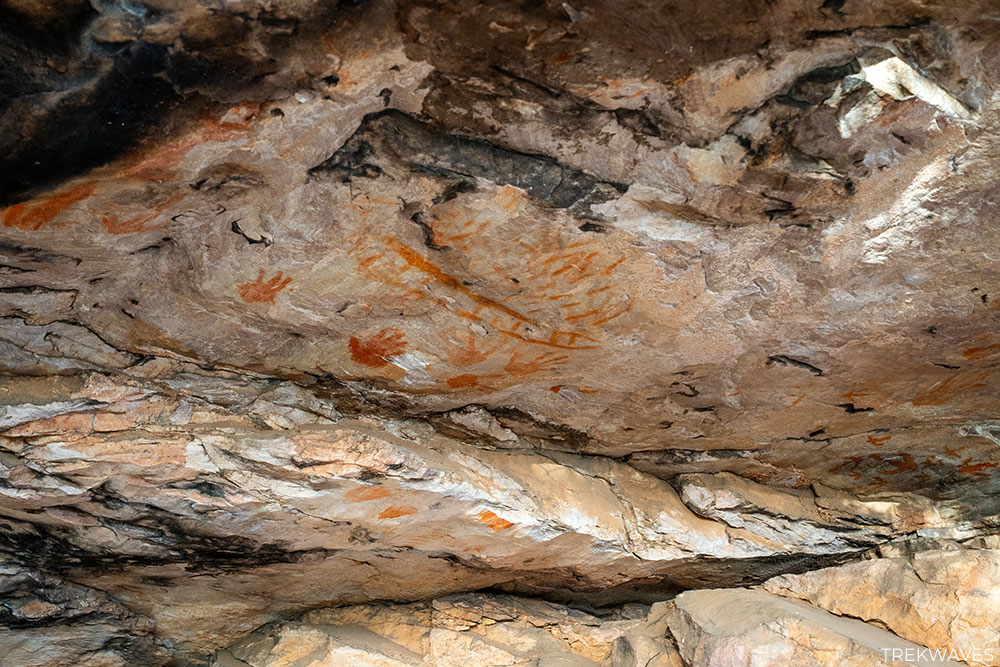
Hollow Mountain Summit: Trail Overview
Though short in distance, this is the most popular hike in the area, requiring a good level of fitness and agility to navigate its challenging terrain.
- Start & finish: Hollow Mountain Carpark
- Distance: 2.4km return
- Elevation gain: 155m
- Time: 1.5-2 hours
- Difficulty: Moderate to Hard (rock scrambling involved)
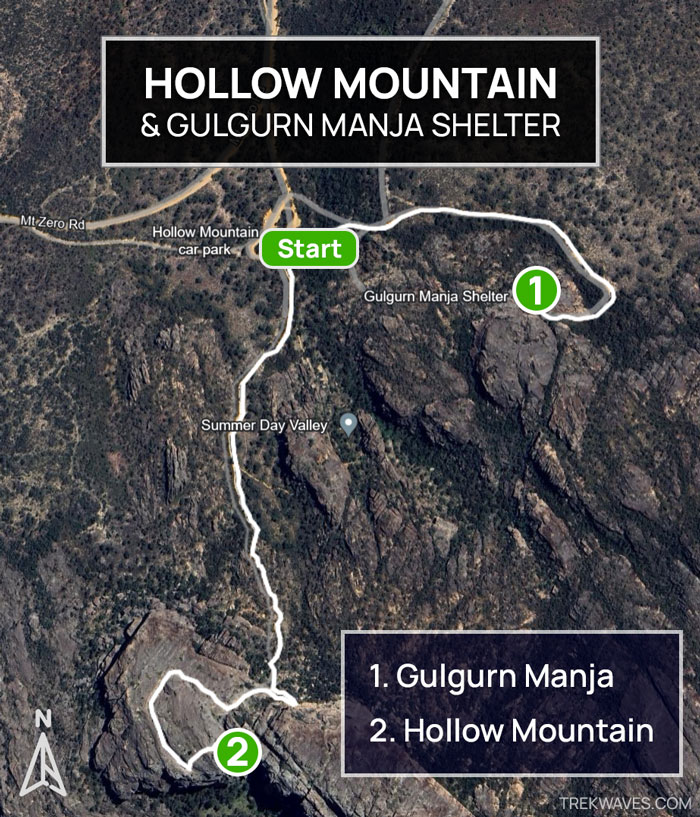
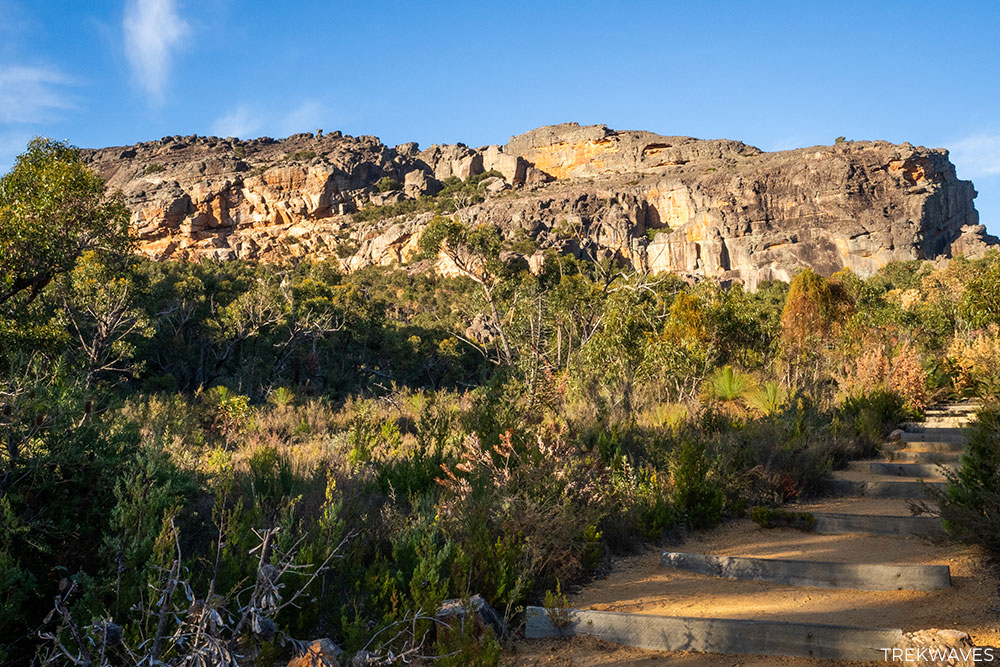
Hollow Mountain Trail Highlights
While relatively short in distance, this hike makes up for it with the intensity of its challenges.
The opening section of the trail is easy to navigate, with a clear dirt path and numerous steps, passing through open native bush, dotted with rocky outcrops and the occasional wildflowers.
1. Rocky Scramble
After a few hundred meters, the terrain starts to shift, and the dirt path transforms into a rocky scramble.
Following the yellow markers that serve as your guide, you’ll come to the base of a towering cliff.
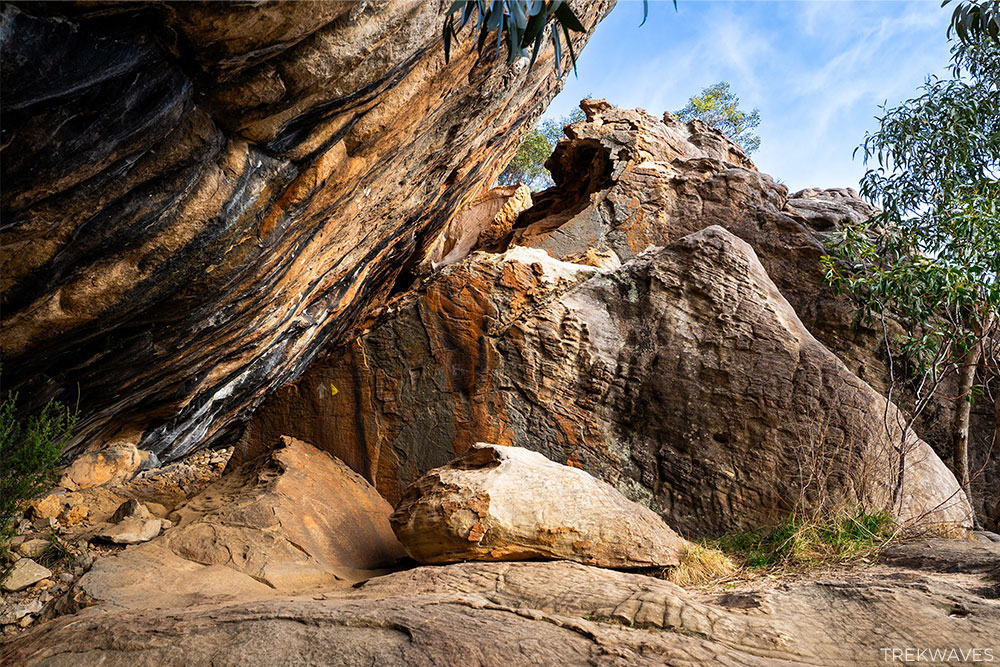
Here, the trail shifts from a simple scramble to a rock climb, requiring you to carefully use handholds and footholds carved into the rock to scale the steep rock faces.
Some sections require you to wedge yourself between boulders or hoist yourself up natural rock steps, adding to the sense of excitement.
Agility and careful footwork are key in this portion of the trail.

2. Hollow Mountain Cliff Wall
Upon completing the first, perhaps the most demanding section of the trail, you’ll get close to the wide and tall, orange cliff wall.
This was my favourite part of the trail, as the fast-moving clouds and the early morning sunlight reflecting off the orange walls created a truly magical scene.

Heading left along this wall will take you to a viewpoint that’s definitely worth a visit; afterward you can turn back and follow the path along the wall, leading you toward the narrow cave opening.
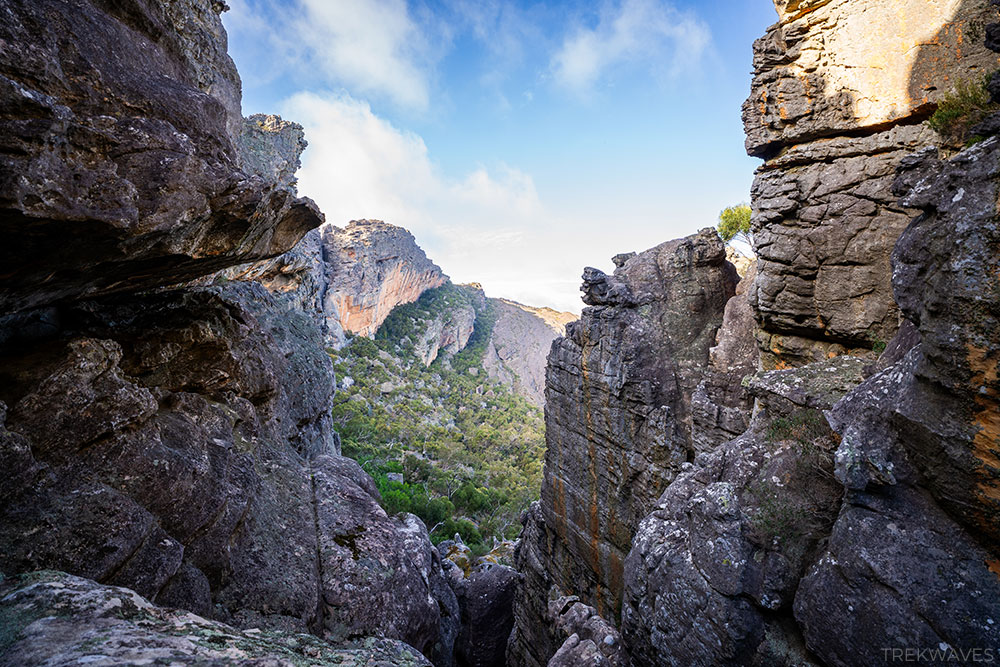
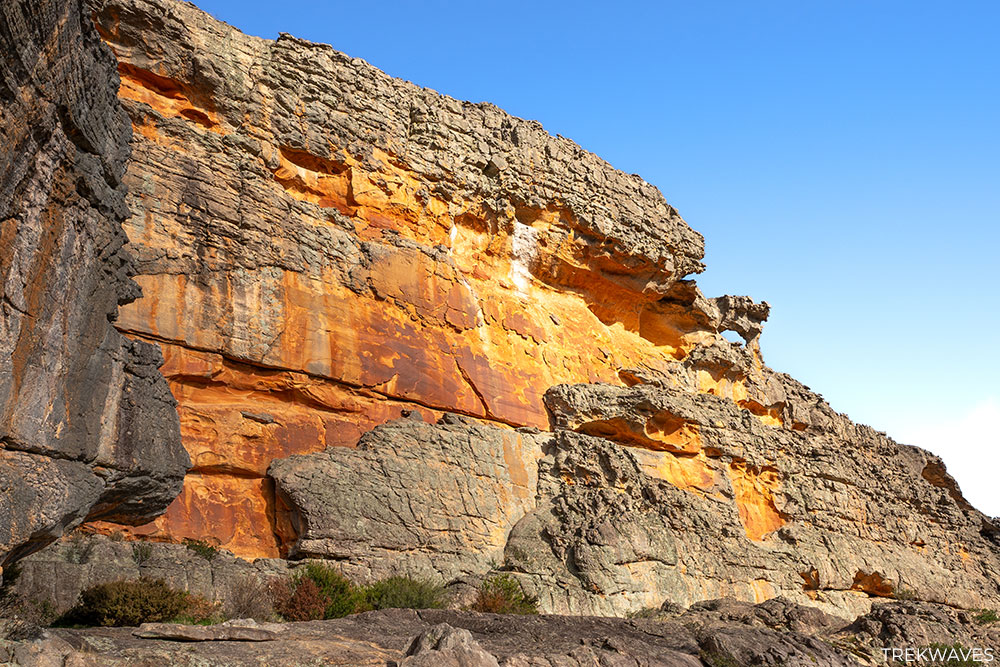
3. Hollow Mountain Caves
Continuing along the wall leads you to a small rock cave with a tight passage that demands a bit of agility to squeeze through.
Once inside, you’ll find a cool, shaded area that offers a refreshing contrast to the exposed rock surfaces you’ve been walking on for most of the trail.
This cave is an excellent place for a quick rest and to snap a few photos.

I recommend taking more time than I did to explore this section of the trail, as there are more caves to discover along the way.
Unfortunately, I was pressed for time and headed straight to the Hollow Mountain summit.
4. Hollow Mountain Summit
The final section of the trail is relatively easy, though it is quite steep. As you continue upward, you’ll be rewarded with magnificent views of Mount Zero and expansive flat plains stretching to the west and north.

Eventually, you’ll arrive at the final lookout spot, which may feel like the end of the trail.
However, if you turn around and head back, you’ll see a sign directing you toward the summit of Hollow Mountain, only a 50-meter climb from there.


At the summit, you’ll be treated to expansive views of the surrounding plains, Mount Stapylton, Mount Zero and the picturesque landscape of the Northern Grampians.
The striking contrast between the rugged rocks at your feet and the vast, ancient volcanic plains below is truly captivating.

Final Thoughts
Hollow Mountain is more than just a hike; it’s an immersive experience that combines the thrill of rock scrambling with a deep connection to Aboriginal culture.
Whether you’re here for the adrenaline rush of the summit or to reflect on the ancient rock art, this hike offers something for everyone.
Just remember to bring your adventurous spirit—and a camera for those incredible summit views.
Found it helpful? Pin it for later!
